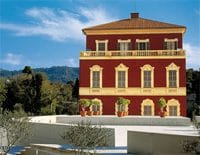
In an ideal setting, conducive to rest and relaxation, the large red building stands prominently. In the still magnificent garden of Cimiez, just steps away from the Roman ruins, Henri Matisse awaits us to share his work and his life.
It is a beautiful day on this cold December day. While the hour is one of frenzy and hysteria in the shops to best prepare for the festive days ahead, I have decided to take a step back and gain a little perspective. And what better way to abstract from the commercial hustle than a visit to a museum.
My choice fell on Henri Matisse because his memory is still very present in the region, notably in Vence with his famous chapel.
Thus, the Matisse Museum is located on the hill of Cimiez, a few steps from the Regina where Henri Matisse lived. Inaugurated in 1963, this place of culture symbolizes the artist’s deep attachment to our city. What visitors see is the culmination of a long progression through the decades. Originally, visitors coming to the Villa des Arènes could discover two museums: on the ground floor, the Archaeology Museum and on the first floor the Matisse Museum. In a desire to expand and develop the museum, an enlargement was carried out during the 90s. The Archaeology Museum moved to make room for displaying as many works of the artist as possible. To respect the Roman site and the villa, the new wing of the museum develops underground over two levels. In 2002, the museum took its current shape, with a significant exhibition surface, an auditorium, a bookstore, as well as an artistic initiation workshop and a drawing office.
“There are flowers everywhere for those who really want to see them.”
The museum is arranged to show the artist’s progression and thus provide an overview of his work. The major works of the museum are “Blue Nude,” “Creole Dancer,” and “Still Life with Pomegranates.”
There are 2 types of exhibitions, permanent and temporary.
The permanent collections are presented in the Villa des Arènes itself. On the ground floor, in the entrance hall, a Kouros that was in the artist’s apartment at the Regina greets the visitor who can choose between a painting section and a graphic art section. The collection begins with his earliest canvases such as “Still Life with Books,” painted in 1890. The painter showcases, through this masterpiece, the major steps of his discovery of light and use of color.
The graphic section is organized around the different techniques experimented by the master: drawings in pen and charcoal or lithographs. These two sections allow, in their entirety, to grasp the dialogue that has been established between drawing and painting, black and white and color.
The temporary exhibition currently presents sculpted works belonging to the museum’s collection. It gathers the majority of Henri Matisse’s sculptures. The eponymous museum has the privilege of conserving the largest part, 57 out of the existing 84, some of which are considered the most important. Each of these sculptures represents a step for the artist, a milestone in the creative process that animated him throughout his life. They thus constitute an important source of precise information, allowing a better understanding of the artist’s pictorial and graphic work.
First French monographic museum!
The museum has a Documentation Center that gathers close to 8,000 works including documents on the history of art and of course Henri Matisse. All these documentary resources and archives are accessible to researchers. It’s also important to note that the museum is the first monographic museum on Henri Matisse in France and the second Matisse museum after the one in Beaubourg.
During this school holiday period, it should be noted that you can bring your children to discover the world of the painter. In an effort to broaden its audience, the museum management has set up for children an artistic workshop open on Wednesday afternoons and during school periods to show them Matisse’s work through cut-out gouached paper.
It’s also worth mentioning, and it’s rare enough to highlight, that the museum is completely accessible to people with reduced mobility, thanks notably to the installation of elevators, access ramps, and a lift.
A great idea for an outing, if ever there was one. A cultural immersion in the world of art that allows us to realize that our region has inspired some of the greatest contemporary artists, from Chagall to Picasso, through Ben and Cézanne. And how comforting that is in this star academy period…
Sébastien Griffet